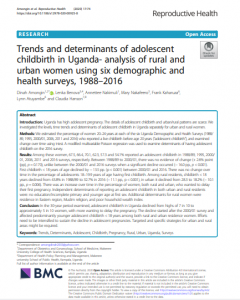
Introduction
Uganda has high adolescent pregnancy. The details of adolescent childbirth and urban/rural patterns are scarce. We investigated the levels, time trends and determinants of adolescent childbirth in Uganda separately for urban and rural women.
Methods
We estimated the percentage of women 20–24 years at each of the six Uganda Demographic and Health Surveys (1988/89, 1995, 2000/01, 2006, 2011 and 2016) who reported a live childbirth before age 20 years (“adolescent childbirth”), and examined change over time using t-test. A modified multivariable Poisson regression was used to examine determinants of having adolescent childbirth on the 2016 survey.
Results
Among these women, 67.5, 66.4, 70.1, 62.3, 57.3 and 54.1% reported an adolescent childbirth in 1988/89, 1995, 2000/01, 2006, 2011 and 2016 surveys, respectively. Between 1988/89 to 2000/01, there was no evidence of change (+ 2.6% point (pp), p = 0.170), unlike between the 2000/01 and 2016 surveys when a significant decline occurred (− 16.0 pp., p < 0.001). First childbirth < 18 years of age declined by − 13.5 pp. (p < 0.001) between 2000/01 and 2016. There was no change over time in the percentage of adolescents 18–19.9 years of age having first childbirth. Among rural residents, childbirth < 18 years declined from 43.8% in 1988/89 to 32.7% in 2016 (− 11.1 pp., p < 0.001), in urban it declined from 28.3 to 18.2% (− 10.1 pp., p = 0.006). There was an increase over time in the percentage of women, both rural and urban, who wanted to delay their first pregnancy. Independent determinants of reporting an adolescent childbirth in both urban and rural residents were: no education/incomplete primary and younger age at first sex. Additional determinants for rural women were residence in Eastern region, Muslim religion, and poor household wealth index.
Conclusion
In the 30-year period examined, adolescent childbirth in Uganda declined from highs of 7 in 10 to approximately 5 in 10 women, with more wanting to delay the pregnancy. The decline started after the 2000/01 survey and affected predominantly younger adolescent childbirth < 18 years among both rural and urban residence women. Efforts need to be intensified to sustain the decline in adolescent pregnancies. Targeted and specific strategies for urban and rural areas might be required.